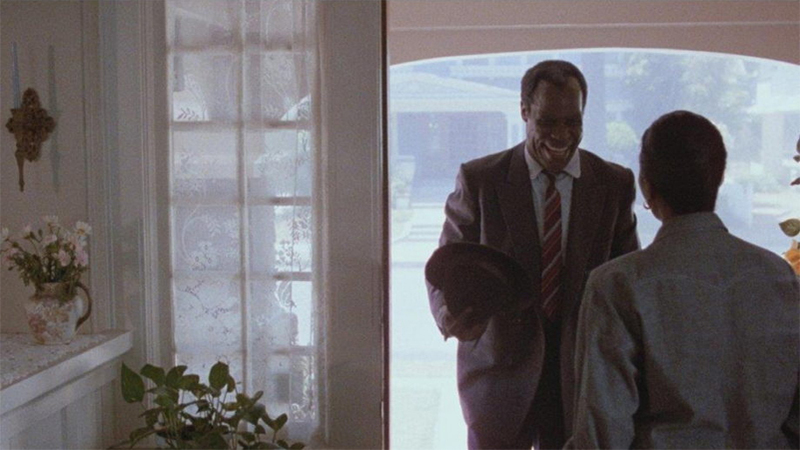To Sleep With Anger
Mar 20, 2019
To Sleep With Anger was Charles Burnett’s third feature film, although it was his first to receive any kind of theatrical distribution, which is reflective of institutional, financials, and cultural challenges faced by independent black filmmakers. Burnett had first garnered attention for his independently produced feature debut Killer of Sheep (1977), a low-budget, black-and-white drama about a slaughterhouse worker that he wrote, directed, and acted as cinematographer. Although it was not theatrically distributed, it played at numerous film festivals and was critically acclaimed, which helped Burnett to win a Guggenheim Fellowship, part of which he used to produced his follow-up feature, My Brother’s Wedding (1983), a family drama that again failed to secure distribution. Although he remained active over the next half decade, working as a writer and cinematographer on other people’s projects, Burnett wouldn’t manage to direct another feature until the end of the decade, which was enabled by his winning a MacArthur Foundation genius grant in 1988.
The resulting film, To Sleep With Anger, is a fascinating slow-burn drama about a middle-class black family whose relatively staid life is upended by the unexpected arrival of an old friend they haven’t seen for decades. Gideon (Paul Butler) and Suzie (Mary Alice) live in a large, rambling house in South-Central Los Angeles. Having moved west from Memphis, Tennessee, ages ago, they still hold onto various Southern rural traditions, including gardening and raising chickens in the backyard. They have two grown sons: Junior (Carl Lumbly) and Babe Brother (Richard Brooks), both of whom are married. While Junior is a reliable and consistent man, Babe Brother is struggling with his place in life, chafing against the upwardly mobile dreams of his buppie wife Linda (Sheryl Lee Ralph), who has little interest in the old and traditional ways of her husband’s family. Junior resents what he sees as Babe Brother’s self-centeredness, while Babe Brother resents what he sees as Junior’s privileged status in the family, which he blames for the friction he has with their father (he is the envious Cain to Junior’s respected Abel, one of the film’s many Biblical allusions, and their relationship reflects the one at the center of Burnett’s previous film, My Brother’s Wedding). Thus, there are already tensions at the heart of the family, which will be fanned into much harsher flames by the arrival of Harry (Danny Glover), an old friend of Gideon and Suzie’s who shows up unexpectedly at their doorstep one morning and become a seemingly permanent fixture in their home.
Although not immediately apparent, Harry is a harbinger of evil, although how and why he manifests such malevolence is left tantalizingly vague. Mining African American narrative traditions and folklore, Burnett casts Harry as the folkloric ‘œtrickster,’ someone who appears innocuous, but in fact brings trouble wherever he goes with his cunning and deceptive ways. In an anthropological analysis of the film, Ellen L. O’Brien noted that Burnett was inspired by the ‘œHairy Man,’ a staple of Southern folklore who steals vulnerable souls, although he never goes so far as to confirm that Harry is in any way supernatural. He leaves it up to us to determine whether Harry is a truly evil spirit or just a bad man with a penchant for disrupting relationships and using people to his own ends.
We see this particularly in his interactions with Babe Brother, as he manipulates the younger man’s insecure secure identity and unfulfilled desires to drive a wedge between him and his family (Harry is aided and abetted by several older friends of Gideon’s who are drawn to Harry’s evocation of the ‘œold days’ and are all too willing to lend support to his devious words). We also see this clearly in his interactions with Hattie (Ethel Ayler), another old friend who in her early years was wild and sexually indiscriminate, but has since repented and settled into a more respectable, Christian life (as she puts it, ‘œsome people grow up and change’). Harry, however, refuses to see her change and instead constantly brings up the old days, when she ‘œwasn’t saved,’ which at first feels simply rude and irritating, but later reveals itself to be one of his many means of disturbing those who are at peace, riling up old memories not for pleasure, but for pain and discord.
Burnett establishes the presence of superstition and the supernatural in subtle ways during the film’s early scenes. When we are first introduced to Gideon, we see him searching for his ‘œtoby,’ a traditional charm that is intended to ward off illness (he never finds it, which is connected with his later suffering a mysterious stroke that leaves him bedridden and seemingly at the edge of death). When Harry first arrives, he reacts viscerally to Gideon and Suzie’s grandson Sunny (DeVaughn Walter Nixon) accidentally touching his feet with a broom, an action that is thought to draw bad luck. After Harry’s arrival, there are numerous unexplained events’” the child next door who had been practicing his trumpet is suddenly unable to play in tune, characters inexplicable drop eggs and jars on the floor, Junior’s wife Pat (Vonetta McGee) feels her unborn child thrashing inside her, and of course the aforementioned illness that strikes Gideon’”all of which could easily be dismissed as simply odd occurrences except that they accrue only after Harry’s arrival.
Burnett was able to get To Sleep With Anger produced and distributed partially because of Danny Glover’s involvement (in addition to his role as Harry, he also served as an executive producer). Glover had just achieved major stardom, having played opposite Mel Gibson in the second installment of the lucrative Lethal Weapon franchise the previous summer (it was the third highest grossing film of 1989 behind Batman and Indiana Jones and the Last Crusade) and having been nominated for an Emmy for his performance in the popular television miniseries Lonesome Dove. Glover brings a quiet insidiousness to the role that is entrancing; it is not hard to see why characters are both attracted to and repelled by him. Mary Alice, who at the time was known primarily for her work on television (including the Cosby Show spin-off A Different World) is also outstanding as Suzie, a quiet, decent woman trapped in the middle of an impossible situation. She is the matriarch who must hold things together when it all starts falling apart, and it is not incidental that, when the worst appears to be about to happen after Junior and Babe Brother finally come to blows and a knife is involved, that it is all the women who step in and restore order.
Although it did not receive much attention at the time of its limited theatrical release (the film’s distributor, The Samuel Goldwyn Company, seemed to have no idea how to market it), To Sleep With Anger has over the years acquired growing recognition as an exemplary drama that reveals more and more narrative, emotional, and thematic layers each time you see it. Although it at first appears to be a rather slow-moving family drama, close attention to the details reveals it to be a superb and nuanced evocation of conflict’”not just between and among family members and friends, but between the past and the present, tradition and modernity, superstition and religion. The film may have been a bit too subtle for audiences at the time, and it fell through the cracks of the wave of new black cinema that was hitting U.S. theaters in the late 1980s and early ’90s, almost all of which were centered around young characters dealing with life in the ghetto (the South Central depicted in To Sleep With Anger is very different from the one depicted in John Singleton’s Boyz N the Hood and Allen & Albert Hughes’s Menace II Society). Interestingly, its most labored sequence is also its most overt, as the film’s credit’s unfold over a shot of Gideon sitting in a chair dressed in a white suit and being slowly consumed by flames in what is suggested to be a dream, but plays most obviously as symbolic foreshadowing of what is to come.
Unfortunately, despite the film’s significant artistic achievement, Burnett has continued to struggled to find a reliable place in mainstream cinema, working primarily in documentaries and decidedly commercial made-for-television movies. One can only hope that he will be able to marry his unique and compelling cinematic voice with deserving projects in the future.
To Sleep With Anger Criterion Collection Blu-ray
Aspect Ratio
1.85:1AudioEnglish DTS-HD Master Audio 2.0 surroundSubtitles
EnglishSupplements’œOf Family and Folklore’ featurette
‘œA Walk with Charles Burnett’ featurette
Short video tribute to Burnett produced for the Academy of Motion Picture Arts and Sciences’ Governors Awards ceremony in 2017
Essay by critic Ashley ClarkDistributor
The Criterion CollectionSRP
$39.95Release Date
February 26, 2019
COMMENTS
Criterion’s new Blu-ray edition of To Sleep With Anger, which marks the film’s first release on U.S. home video since the VHS days, boasts a new 4K restoration from the original 35mm camera negative, whose cleaning and color-correction was approved by director Charles Burnett. The image is quite lovely, with an earthy, burnished look that is in keeping with the film’s tone and themes. At times it can appear quite grainy, but that is inherent to the source material and feels right for the film. The cinematography is generally warm and slightly soft, although detail and contrast remain outstanding. The two-channel surround soundtrack was remastered from the LCR magnetic track and sounds very good. Ambient noise and general atmospheric sound are well rendered in establishing the environments, and the dialogue is clear throughout.
Criterion has put together a number of new supplements, starting with ‘œOf Family and Folklore,’ an informative new 24-minute featurette based around new video interviews with Burnett, actors Danny Glover and Sheryl Lee Ralph, and associate producer Linda Koulisis. We also get ‘œA Walk with Charles Burnett,’ a nearly hour-long program centered around a conversation between Burnett and filmmaker Robert Townsend about Burnett’s filmography and the locations in South Central Los Angeles where he shot Killer of Sheep and To Sleep With Anger (it was originally produced for Criterion’s Meet the Filmmakers series in 2018). Finally, the disc includes a short video tribute to Burnett that was produced by filmmaker Shola Lynch in 2017 for the Academy of Motion Picture Arts and Sciences’ Governors Awards; it features Burnett; directors Julie Dash, Reginald Hudlin, and Robert Townsend; actors Danny Glover, James Earl Jones, Carl Lumbly, and Sheryl Lee Ralph; and cinematographer Bradford Young.
Copyright © 2019 James Kendrick
Thoughts? E-mail James Kendrick
All images copyright © The Criterion Collection



